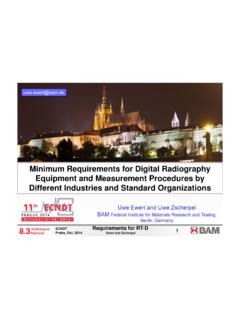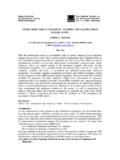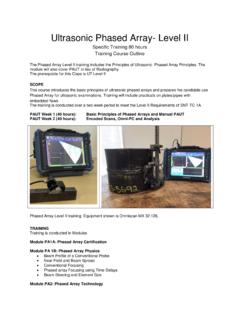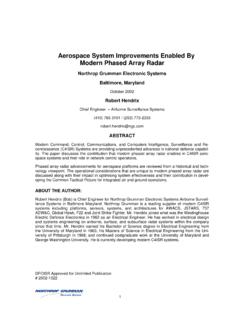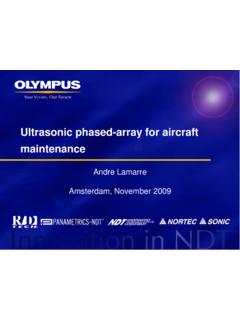Transcription of FAAST Very Fast Phased Array System - ndt.net
1 License: 19th World Conference on Non-Destructive Testing 2016 FAAST Very Fast Phased Array System Xavier HARRICH 1, Philippe COPERET 1 1 Socomate International, Crecy la Chapelle, France Contact e-mail: Abstract. FAAST is a UT Phased Array System especially designed to meet with the High Productivity inspection needs, thanks to its outstanding capability at replacing multiple conventional Phased Array systems working in parallel. FAAST Patented Linear Pulsing Generator allows multi-beams transmission within ONE SINGLE SHOT throughout 1D Linear, but, overall, 2D MATRIX Probes awarding it thus a huge advantage. The first industrial application being built by SOCOMATE and requesting this Phased - Array technology is for rail inspection on-track at a speed of 100km/h with only one 1D multi-element Probe generating up to 16 oriented beams from 20 to 70 WITHIN A SINGLE SHOT.
2 References in OCTG Tubing Market for which FAAST gives the possibility to meet with the most severe API Standard requirements for both services companies and high productivity The FAAST can detect and Process in Real Time all oriented reflectors in tube by generating multi-oriented beams, WITHIN A SINGLE SPRAY throughout a 2D MATRIX Array Probe, into Seamless tubing up to 450mm for the detection of Longitudinal, Transversal & All Oblique Notches every 5 Step over the 360 circumference of tube, for both extremity and full-body inspection. Delamination detection and Wall Thickness measurement are provided with a 1D-LINEAR Array Probe. Reference in High Precision and Umbilical Tubing up to 50mm for the detection of both Longitudinal & Transversal Notches, with only one Bi-LINEAR Array RING Probe and at up to 24 m/min Linear Feeding Speed.
3 Associated to our Patented System for full Dimensional Measurement (OD, WT, ECC, ID, OV), a solution is now available as the Unique Option to Rotary Heads on Linear Feeding lines, and with NO MECHANICAL ROTATING MOVEMENT, for easy and quick Probe Positioning & Calibration, as well as for cut down Maintenance Costs. Reference in Aircraft Industry for special alloy and titanium turbine disc inspection complying with Multi-zone testing procedures aiming at the detection of down to FBH at up to 140mm depth from the surface. Multi-zone testing procedure requests Multi-focused and/or Multi-oriented beams generation WITHIN A SINGLE SPRAY throughout a 2D MATRIX Array Probe, reducing thus considerably the inspection time per turbine disc. Introduction FAAST is a UT Phased Array (PAUT) System which is much more powerful than conventional Phased Array System .
4 Thanks to its technology, the FAAST System has the More info about this article: to transmit multiple sound beams, multi-oriented and/or multi-focused, through multi-element probes with only one single shot, and then to process signals received from all beams in real time. This patented technology (WO 03029808) revolutionizes the NDT environment when speaking about UT inspection due to its high speed testing capabilities, as it is able to replace several conventional Phased Array systems running in parallel. At higher inspection speeds, it offers even more savings due to the reduction of Phased Array probes, mechanical parts, maintenance and calibration time. Furthermore, as well as FAAST increasing productivity due to its capabilities, it can also be perceived as a very flexible System which can save you lots of money.
5 As an example, if today, a customer only requires Longitudinal and Transversal flaw detection, perhaps tomorrow the requirement will be to inspect for oblique flaws. Simply by configuring the software settings regarding the delay laws of FAAST technology, one inspection configuration can be easily upgraded in order to meet with any new requirements. The FAAST technology can be applied to any type of application (Tubes, bars, plates, aircraft components, railroad, ), on different materials (Titanium, Aluminium, Steel, Special Alloy, Copper, Composites, ) and in any industries. To demonstrate the System capabilities, we invite you to read the different possibilities that the FAAST Phased Array technology offers. The Phased Array FAAST can operate in standard Phased Array acquisition modes for example, electronic scanning, sector scanning, sequential shooting, as well as with advanced acquisition modes.
6 FAAST Technology has at least equal performance to conventional Phased Array and can easily and rapidly respond to any upcoming increase of productivity, quality, standards, or customer requirements. Although the System offers many advantages, FAAST Phased Array technology can be used in a similar environment and application as conventional Phased Array without compromising the results. Why would it be beneficial to have a FAAST Phased Array System installed on an inspection System ? To use its flexibility! Today higher inspection speeds or even the inspection with further angles might not be needed, but what about tomorrow? With conventional Phased Array , it would be necessary to increase the number of probes so the mechanics would have to be modified, more UT electronics added and all parameters set up once again, whereas with FAAST Technology it is only a matter of changing the Software parameter settings, to keep the same productivity.
7 Examples: To use Phased Array FAAST as a conventional System , to then enjoy a modular System : Start with a System using sequential firing in different angles as it would happen with a conventional Phased Array unit. This would take several pulse shots to cover the required angles. Upgrade the System by using the advanced acquisition mode Multi-angle . This acquisition mode covers all the required angles with one pulse shot which allows increased productivity if needed, or may increase quality by covering more angles in order to comply with new standards or customer requirements. Start with a System using sequential shooting to create different focus distances as it would happen with a conventional Phased Array . Upgrade the System by using the advanced acquisition mode Multi-focus.
8 This acquisition mode allows different focussed distances to be created simultaneously with one shot to increase productivity. Start with a System using sequential multibeam acquisition mode with different focus distances or angles. Upgrade the System by using the advanced acquisition mode Multibeam combined with Multi-angle or furthermore Multibeam combined with Multi-focus . FAAST Technology has at least equal performance to conventional Phased Array and can easily and rapidly respond to any upcoming increase of productivity, quality, standards, or customer requirements. Multiangle acquisition: The multi-angle is one of the prominent capabilities of our Phased Array FAAST (PAUT) for generating multiple beams using a multi-element probe and up to 16 beam orientations or even more, are generated simultaneously in one single shot.
9 Signals are processed in real time, up to 16 directions simultaneously, but this does not restrict the number of beams. This advanced acquisition mode can be used with either 1D linear probe or 2D Matrix multi-element probe. 1D Linear probe: With Phased Array FAAST , one single shot is required to transmit several beams in the probe s incidence plan, which can go up to 16 different direction in real time (but does not restrict the number of beams) compared to conventional Phased Array , where several sequential shots are required to perform the inspection. Please find hereafter the comparison with illustrations. Shot 1: -45 Shot 2: 0 Shot 3: + 45 Shot 1: 45 and 0 2D Matrix probe: The advanced multi-angle acquisition mode combined with a 2D Matrix probe is the perfect combination when looking for transverse, longitudinal and oblique flaws simultaneously.
10 Our technology offers the possibility to transmit multiple orientation beams using only one multi-element probe and in one single shot, satisfying the requirements of high productivity lines. Below is a typical example where our FAAST technology could be shown as very flexible, compare to conventional Phased Array : An inspection System has been supplied for the inspection of 2 longitudinal, 2 transversal and 4 oblique flaws (CW and CCW). If tomorrow the customer needs to inspect say 8 oblique angles (or more) instead of 4, in order to increase the inspection quality or to comply with a more severe standard, with conventional Phased Array it would require either to add more probes or to slow the production line, leading to a lower productivity. More UT electronics would then be required in order to keep the same productivity, which will lead to more calibration time, more maintenance costs, etc.

